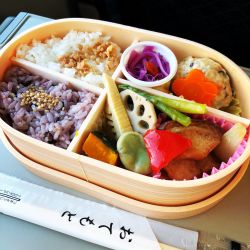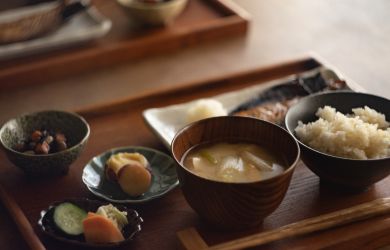
Originally published on metropolis.co.jp on February 2012

The Boston Globe food writer’s list of markets, shopping areas, izakaya, utensils and staples for the larder include some classics—as well as some surprising suggestions.
The “top market” gong goes to Ameya Yokocho (“candy store alley”). Found along the Yamanote tracks between Okachimachi and Ueno, “Ameyoko” was a postwar black-market site, and now sells everything from clothes to fresh fish. Within it, Ameyokoyaki (6-4 Ueno, Taito-ku) serves up mini-okonomiyaki in standing-counter style. Samuels tips Shoryu (6-10-14 Ueno) for giant gyoza and gomoku kata yakisoba (stir-fried vegetables over crispy noodles). Sankoen will sell you nori and tea (6-10-3 Ueno; www.ameyoko.net/shop/154), Iseoto Shoten, bonito flakes (6-4-10 Ueno; www.iseoto.com), and Marudai, meat (6-10-7 Ueno; http://marudai-ameyoko.jimdo.com).
“Grannies’ Harajuku,” aka Jizo dori in Sugamo, is Samuels’ spot for certain ingredients. Hit Jizo dori Raijindo for sembei (3-33-23 Sugamo, Toshima-ku; www.e-fujiichi.co.jp), Kawamuraya for pickles (3-21-15 Sugamo; www.kawamuraya.co.jp), Tanakaya for handmade udon (3-22-9 Sugamo, Toshima-ku), and Nataritei for black garlic—a unique snack (4-28-3 Sugamo, Toshima-ku, www.natary.co.jp).
Favorite shopping areas include Kappabashi, near Asakusa, for kitchenware, and Tsukiji Masamoto for knives (4-9-9 Tsukiji, Chuo-ku; www.tukijimasamoto.co.jp).
When she’s not whipping up feasts at home, Samuels gushes over the food and presentation at two izakaya in particular—Robata Honten (1-3-8 Yurakucho, Chiyoda-ku) and Maru (Aoyama KT Bldg. B1, 5-50-80 Jingumae, Shibuya-ku; www.maru-mayfont.jp). For sushi, she swears by Sakae Sushi in Okachimachi (5-27-6 Ueno, Taito-ku). Run by chef Kagawa and his son-in-law, this tiny shop requires a reservation.
To have on hand for home cooks, a favorite pantry item is hon mirin (sweet rice wine) used for sauces, stews, and as a substitute for sugar in salad dressings. Sanonto (Japanese brown sugar) is recommended for teriyaki and bonito flakes—Samuels saves it after making dashi and repurposes it as an onigiri stuffing.
At the ¥100 shops, Samuels likes to pick up saibashi (long chopsticks for cooking), mini suribachi (pestles and mortars), and furikake (rice condiment), “not only for topping on rice, but for mixing with cream cheese and serving with crackers or as a topping for salads.”
The Bostonian also highlights the generic box grater found with different cutting lids. “This tool can be used across cuisines,” she declares, putting it to use for salad dressings or meatloaf. Also useful for ginger, daikon, and stale bread.
For tableware, the writer uses soy sauce bowls to serve sauces, salts, and salad dressing. Hashioki (chopstick rests) can be used as a rest for silverware or even as table decorations themselves.
My Japanese Table (Tuttle, 2011, pp.176), ¥2,700 from major bookstores and Amazon.jp.
Eriko’s Nasu no nimono (“Simmered Eggplant”)

Published with kind permission of the author Debra Samuels
My dear Japanese “sister,” Eriko, taught me how to make this dish. The small eggplants are initially cooked in a bit of oil and then sprinkled with sugar, forming a caramelized crust. They are then simmered in dashi (fish stock) and seasonings with dried red pepper, until they are as soft as feather pillows. A drop lid cover (otoshibuta) is set on the simmering eggplants to keep the liquid concentrated towards the vegetables. A piece of parchment or aluminum foil will work as well. Japanese eggplants are small and slim, and their skins are tender. This matters because in this recipe the vegetable is not peeled. They most closely resemble Italian eggplants in length and Chinese eggplants in width. Use either variety for this recipe.
- 6 Japanese or Italian eggplants (small and narrow)
- 3 cups (750 ml) water
- 2 teaspoons salt
- 3 tablespoons canola oil
- 11⁄2 tablespoons sugar
- 1 small dried red pepper, chopped or 1⁄4 teaspoon red pepper flakes
- 1 cup (250 ml) water or dashi stock
- 21⁄2 tablespoons soy sauce
- Parchment paper, cut into a circle slightly smaller than the diameter of the pan
- 1 Cut eggplant in half length-wise. Lightly score the skin side with lattice marks.
- 2 In a large bowl add water and salt. Add eggplant and soak for 10 minutes.
- 3. Remove eggplant and dry thoroughly with paper towels.
- 4 In a large sauce pan, heat the oil over medium heat.
- 5 Place the eggplant, skin side down, and fry for 2 minutes until skin begins to separate and turn light brown. Turn over and cook an additional 2 minutes.
- 6 Add sugar and continue to cook the eggplant, turning once, until crust begins to form.
- 7 Add 1 cup (250 ml) of water (or dashi stock if using) and the dried red pepper.
- 8 Bring to a boil and place parchment paper directly on the eggplant. Lower the heat and simmer for 10 minutes, until the eggplant is soft.
- 9 Remove the paper and add the soy sauce.
- 10 Raise the heat, returning it to a boil and cover with paper again.
- 11 Cook for an additional 5 minutes or until most of the liquid is absorbed.
- 12 Serve hot or cold with remaining sauce.







